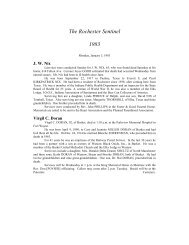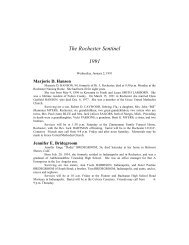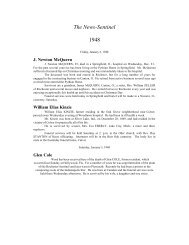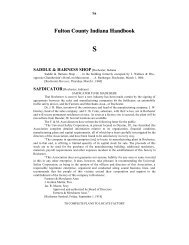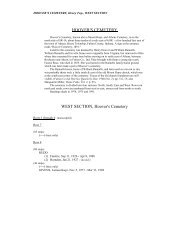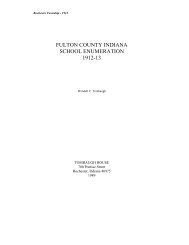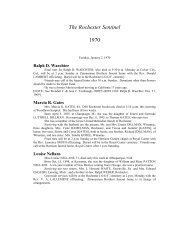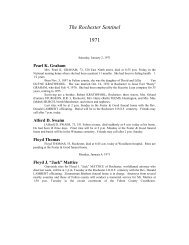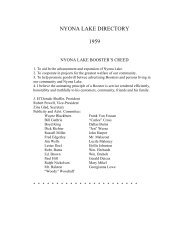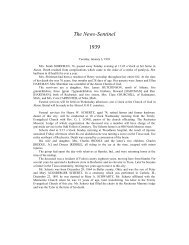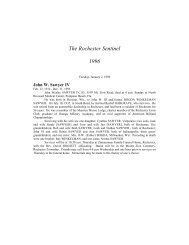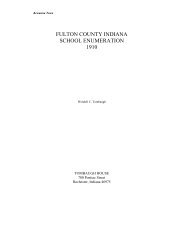Handbook N-P - Fulton County Public Library
Handbook N-P - Fulton County Public Library
Handbook N-P - Fulton County Public Library
You also want an ePaper? Increase the reach of your titles
YUMPU automatically turns print PDFs into web optimized ePapers that Google loves.
Pe<br />
James Malcolm was the first white man to lead the march of civilization into what is now<br />
Perry Township. He came to the country as early as 1833, and obtaining a small log cabin from an<br />
Indian village soon after fixed his home on what is now known as the Jacob Wiles farm, not far<br />
from the southeast corner of the township. “He doubtless entered the deep forest, as did the<br />
majority of young pioneers, with exultant hopes, looking forward to the time when the dense<br />
woods should be cleared away, and when fine farms should appear in their stead.” He lived to see<br />
all these changes take place, but, contrary to his expectations, instead of accumulating a<br />
competency and living to enjoy the same, was compelled to pass his declining years in the county<br />
poor house, where he died a common pauper. The next man who sought a home in the new<br />
country was William Akright, who located in the southeast corner of the township, where Ananias<br />
Harmon now lives, some time in the year 1834. Mr. Akright was in the true sense of the word a<br />
pioneer, and, like his predecessor, was doomed to bitter disappointment, so far as the<br />
accumulation of property was concerned, dying in indigent circumstances in the year 1884. His<br />
son, John Akright, came the same time, figured as an early school teacher of the township, and<br />
later sold goods for a number of years in the village of Gilead. The same year Matthias Moyer<br />
settled near the eastern boundary of the township, where he cleared a good farm and set out one of<br />
the first nurseries in the county. “Benjamin Musulman and Jacob Gill were early settlers in the<br />
same locality, but did not purchase land at that time, both of them leasing a part of Mr. Moyer’s<br />
place.”<br />
During the year 1835, a number of substantial men were added to the population of the<br />
little colony, conspicuous among whom was John Rhodes, who entered a large tract of land near<br />
the central part of the township, upon which he lived the remainder of his life. Unlike the majority<br />
of settlers in a new country, Mr. Rhodes was a man of considerable wealth, by means of which he<br />
was enabled to secure a valuable property and live in comparative ease. His son, Adam E.<br />
Rhodes, accompanied him to this country and settled upon the present site of Gilead, of which<br />
village he was proprietor. He was a man of great energy and superior business qualifications, and<br />
ranked as one of the leading citizens of the county for a number of years. Another prominent<br />
settler of 1835 was Ira Mitchell, who located a short distance east of Gilead, on what is now the<br />
John Baker farm. John Close came the latter part of the same year and made an improvement near<br />
the eastern boundary of the township, and James Waddle is reputed to have been living on the<br />
Samuel Seidner place not far from Niconza, prior to 1836. Among others of 1835, were Peter<br />
Onstatt, two and a half miles southeast of Gilead; James Fiers, on the Tombaugh farm in the<br />
southeast corner of the township; Rev. Wesley Borders, a Methodist preacher and early Justice of<br />
the Peace, in the same locality; Joseph Wildman and his son Joseph, near the Keesling farm,<br />
southwest of Gilead; Alfred Doud, a half mile west of the village; Charles Cleland, in the vicinity<br />
of Dowd’s place; James Cleland, brother of Charles, and an early trader, about four miles<br />
southwest of Gilead; James Biggs, northwest of Gilead; Benjamin and David Marquis, on the<br />
Sickafoos farm; Willis Hill, on the Graft farm, in the southwest part of the township; Jacob<br />
Richard, son-in-law of Alfred, near the central part of the township; John Walters, on the Joseph<br />
Grogg farm; John Anderson and Matthias Bird, near Gilead; and James Bunton, who purcased<br />
land owned at the present time by Jacob Kessling and Fred Kircher, where he died within a short<br />
time after coming to the county.<br />
Prominent among the arrivals of 1836 was Peter Kessling, who, the previous fall,<br />
purchased the land where Willis Hill had settled, to which he moved his family the following<br />
spring. He was a prominent citizen of the township until his death in 1860, and can be<br />
appropriately classed with the early reprsentative men of Miami <strong>County</strong>. His sons, Jacob, Titus,<br />
Peter, James and Jackson, came the same year, and Samuel a little later. They were all substantial<br />
citizens and left the impress of their characters upon the communities in which they resided.<br />
Jacob Kessling, the only one of the brothers here at the present time, is one of the oldest and<br />
wealthiest citizens of the township.<br />
Samuel Shoemaker settled in the southeast corner of the township in 1836, and before the<br />
close of that year the population had been increased by the following comers: Samuel Essick, on<br />
the Timothy Baker farm; Peter Sager, a short distance south of Gilead; Jacob Huffman, in the




